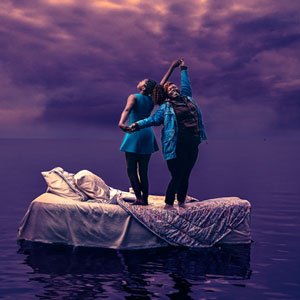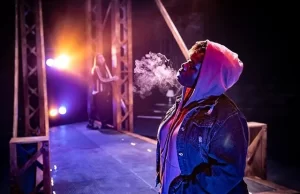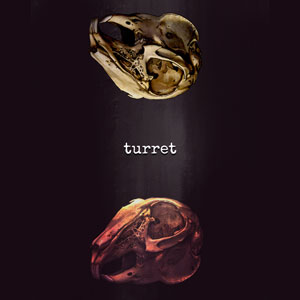
 *** “Jump” is a sobering play about wrestling with thoughts of suicide. We see how each character is obsessed with death in their own way and how each one entertains the likely or remote possibility of ending their own life or thinking about loved ones who might choose to do so. But how do we know if and when other people are contemplating suicide or not? What are the circumstances that might make a person decide to jump? Many people may fail to recognize (or not even realize) when someone near and dear to them might dare entertain this manner of thinking. Or they may get it all wrong. The best part of this show is its focus on the unpredictability of suicide and how death affects those who must live with its consequences.
*** “Jump” is a sobering play about wrestling with thoughts of suicide. We see how each character is obsessed with death in their own way and how each one entertains the likely or remote possibility of ending their own life or thinking about loved ones who might choose to do so. But how do we know if and when other people are contemplating suicide or not? What are the circumstances that might make a person decide to jump? Many people may fail to recognize (or not even realize) when someone near and dear to them might dare entertain this manner of thinking. Or they may get it all wrong. The best part of this show is its focus on the unpredictability of suicide and how death affects those who must live with its consequences.
The play begins when Fay (Jazzma Pryor) and Judy (Jennifer Glasse) return to their family home just after their mother has passed away from cancer. It seems that their father (Alfred H. Wilson) has decided to sell the house and is currently cleaning it out and preparing it for sale. When the sisters reconnect in this setting, they reminisce about old times, particularly what it once meant to share a bedroom and be only three years apart, with Judy being the oldest. It seems that a beautiful bridge could be seen in the distance from this back bedroom, and having this view was the reason why their mother wanted to purchase this particular house. The very first time that she took her two daughters to see the bridge in person was when they were 9 and 12. Apparently, one of her joys was to visit that bridge and walk on the deck and look down at the water below. Yet Fay speculates that perhaps her mother may have once considered jumping off the bridge, although this seems to be more of a random thought than anything else. Perhaps Fay is thinking of herself (rather than her mother) when she expresses this opinion.
Since her mother’s death, Fay would make a special point of coming to the bridge in order to vape. It is there that she meets Hopkins (Jeff Kurysz), who goes there to smoke and forget about his problems. The two of them meet over singing and dancing together, and, in time, they provide social support for each other as they go through their respective life struggles. It is likely that each of them has separately considered jumping off the bridge. Yet the jumping off point for this play is the thesis that Hopkins floats: that those who were not successful in their suicide attempts were not all that sincere in the first place with going through with the deed. He postulates that all the suicide survivors have secretly found a way out so that they didn’t die. But how could his thesis ever be proven? The dead do not return to life to tell us their story. Or do they?
Although Fay is a person of few words and tries to remain as stoic or emotionless as possible, the script ought to make her to express her vulnerabilities and inner conflicts more than she currently does so that these are brought home to the audience more forcefully. The best scenes are those when the father is portrayed, especially in a semi-drunken state, because we can sympathize with Fay’s dilemma regarding her relationship with him, plus we see her as an adult having to deal with his personality. (Considering that Wilson does a remarkable job as the father, we’re in for a treat whenever he takes the stage.) Furthermore, the scene with the two sisters jumping and plopping on their beds together is too long and drawn out. This is the moment when some deeper monologue about their relationship (now as adults) is called for, rather than just reliving the superficiality of their childhood and their teenage years. What I needed was a more profound statement about how contrasts in their personalities set these two women apart—beyond merely differences in clothing and style and whether one of them secretly smoked cigarettes. This moment would have been a good one for the sisters to differentiate among themselves regarding their relationship to their recently deceased mother.
Set design by co-scenic designers Regina Garcia and Lindsay Mummert is clever and imaginative. The audience sits on either side of a square stage, and the stage floor is laid out in sections. Most notably, there is the large and distinctive feature of a mock bridge, complete with piers, a girder, and a bridge deck, with graffiti written on the floor. Its diagonal placement between center stage and one of the wings is nicely done, such that the audience can clearly imagine any remaining architectural details and visualize the water below. There is also a portico entrance to a brick house on one side, a representation of a living room with a comfortable chair, ottoman, and end table in front of the portico, and a (shared) bedroom with two beds, decorated in green and pink with posters of singing groups on the wall plus stuffed animals and awards. Prop designer Jamie Auer has done a wonderful job! Thanks to AmBer Montgomery’s fine work as director, the stage direction between each of these non-contiguous spaces is handled with finesse. Lighting design by Levi Wilkins is accomplished beautifully, especially when the bridge is lit up. Sound design by Christopher Kriz could not be any better, such as when we hear the sound of items being thrown off the bridge that hit the water with a plunk. Costume design by Rachel Lambert is perfect when we see Judy wearing lovely dark teal heels and a matching necklace and Fay wearing athletic shoes and a hoodie; this shows us in an instant how the two sisters are so different from each other. However, when Fay says how she sees this dark shade of teal/blue everywhere she looks but has never really noticed it before, I had to ask myself: Why does no one wear that exact shade of blue that we see in the promotional materials? Note that this is not a fault with the costume design; rather, you’d have to see the show for yourself to understand what this line means!
Written by Charly Evon Simpson, “Jump” takes on a very serious theme, where death is a predestined part of life and where suicide makes the manner of death become your own choice. It is this choice that gives you power over your fate. But why would a person want to exercise that choice? I felt that the script should have explored this idea further, rather resorting to the use of flashing lights to indicate that Fay is somehow living in her imagination or somehow getting a call or a visitation from another dimension. Is she now in communication with her mother in the afterlife? Is her mother beckoning her to join her? Is any of this tied in with precognition of future events? Or is Fay now suffering from a physical illness like getting migraines due to stress—or something worse like epilepsy? Since we really don’t understand why any of this is happening or if the cause is physical or metaphysical, having the audience guess about this doesn’t add anything to the plot. To my mind, the story would be better served if the flashing lights and headaches were omitted.
I won’t ruin the ending for you, but I felt that there should have been more “true confession” earlier on. Later, when all sorts of revelatory stories are supposed to be real and true, are they really? Does the truth of these highly personal admissions have to do with the incorporation of magic into the plot? Or does all of this lie simply within the power of Fay’s imagination? While Hopkins’ hopefulness and support gives Fay strength and comfort through tragedy, it would have been better to have learned something more about him. His personality, like that of Judy’s, comes off being somewhat too superficial. In brief, while “Jump” is a genuinely heartfelt play about suicide and its contemplation, I should have gained a deeper understanding of the characters and the family dynamics—and I should have left the theatre feeling more of a sense of loss and a sense of hope.
“Jump” is playing through June 1, 2024, at Theater Wit, 1229 W. Belmont Avenue, in Chicago’s Lakeview neighborhood.
Tickets – $15-$52
Performance schedule:
 Thursdays, Fridays, and Saturdays – 8:00 p.m.
Thursdays, Fridays, and Saturdays – 8:00 p.m.
Sundays – 3:00 p.m.
No performances: Thursday, April 25th and Thursday, May 16th.
Added performance: Saturday, June 1st at 3:00 p.m.
Masks required performances: Sunday, April 28th. Sunday, May 5th, and Saturday, May 25th.
Note that masks are optional but encouraged for most performances.
Audio Description and a Touch Tour will be offered on Friday, May 3rd. The Touch Tour begins at 6:45 p.m., show at 8:00 p.m.
Open Captions will be provided at the Sunday, May 26th matinee.
For more information and to purchase tickets, visit https://sgtheatre.org/jump/ or call the Theater Wit box office, (773) 975-8150, or visit the box office in person at 1229 W. Belmont Avenue.
For group discounts, email: groupsales@shatteredglobe.org or call (773) 770-0333.
Shattered Globe also offers a waived ticket program to ensure maximum accessibility.
For general information about Shattered Globe Theatre and to learn about their other offerings, go to: https://sgtheatre.org/.
Theater Wit is wheelchair accessible, and all patrons with mobility needs are invited to purchase access tickets with the code ACCESS20 for $20 tickets at Theater Wit’s checkout page. Please also email boxoffice@theaterwit.org to reserve the right seat for your access needs.
Assisted Listening Devices are available for all performances.
To see what others are saying, visit www.theatreinchicago.com, go to Review Round-Up and click at “Jump”.






More Stories
“On The 20th Century” Reviewed by Frank Meccia
“Turret”
“Black Sunday”